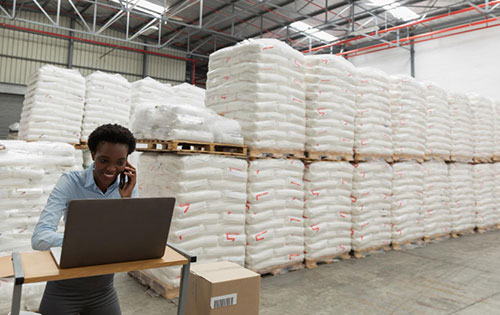How to Successfully Implement Inventory Management Software: A Guide for Food & Beverage Businesses
Built For


In the fast-paced world of food and beverage, the margin for error is razor-thin. Whether it’s missed expiry dates, stock discrepancies, or fulfillment delays, relying on spreadsheets and outdated systems can put your business at risk. Upgrading to an inventory management solution like Acctivate can feel like a big step—but with the right planning and support, the transition can be smooth and game-changing.
In this post, we’ll walk you through how to implement inventory software effectively, address common hesitations, and showcase proven best practices using real food and beverage industry use cases.
Why Food & Beverage Businesses Need to Modernize Inventory Management

Manual processes and spreadsheet-based tracking might work in the early stages, but they simply don’t scale. Common risks in this industry include:
- Spoiled or expired goods due to poor lot tracking
- Stockouts or overstocking from inaccurate forecasting
- Lack of traceability in the event of a product recall
- Inefficient communication between warehouse, purchasing, and sales teams
Modern inventory management systems are built to automate, streamline, and scale your operations—while providing real-time data you can trust.
How to Implement Inventory Software Successfully
Start by identifying what problems you want to solve. Are you looking to reduce spoilage, improve order accuracy, or streamline purchasing? Once you know the key challenges, determine how you’ll measure success. What metrics would prove the system is working? These might include improved inventory turnover, faster fulfillment times, fewer stock discrepancies, or reduced spoilage. Setting clear KPIs at the start gives you a benchmark to track progress.
1. Define Your Goals & Success Metrics
With your challenges in mind, set specific, measurable goals. Consider KPIs like:
- Inventory turnover ratio
- Fulfillment speed or order accuracy
- Reduction in spoilage or expired inventory
- Fewer stockouts or overstock situations
- Lower inventory carrying costs
Having these metrics defined from the beginning gives your team a clear target and helps you evaluate the system’s impact over time.
2. Audit Your Current Processes
Evaluate how your team currently handles:
- Receiving
- Inventory counts
- Stock rotation
- Reordering
- Lot/batch tracking
Documenting your existing workflows—including any workarounds or manual steps—helps identify where inefficiencies or risks exist. This audit ensures the new system supports your real-life operations and highlights areas where automation or tighter controls can make the biggest impact.
3. Choose the Right Software Partner
Acctivate stands out as an inventory system purpose-built for food and beverage companies. Key benefits include:
- Batch and lot tracking
- Expiration date monitoring
- QuickBooks integration
- Mobile barcoding for warehouse teams
- Forecasting tools to reduce waste
4. Create a Migration Plan
With the right plan and support, migrating to a system like Acctivate is a manageable process. Here’s how the typical implementation unfolds:
- Kickoff Call
Meet with your Acctivate Project Director to discuss goals, review responsibilities, gather information about your business processes, and outline your implementation goals. - Configuration & Model Company Setup
Your Project Director configures the Model Company based on your business needs and system settings. - Prepare & Gather Data
Your Project Manager gathers product, customer, and setup data from QuickBooks or your own spreadsheets for import into the system. - Testing & Workflow Review
Test the Model Company setup with your team to confirm that daily processes and workflows function correctly. - Go Live & Final Setup
Your Project Director creates the Live Company, migrates the configuration, and supports you through the transition to live operations.
5. Train Your Team
Successful implementation depends on having a strong internal lead. Your Acctivate Project Director works directly with your Project Manager—providing resources, guidance, and group calls to help them support your team. We expect your Project Manager to coordinate internal training, testing, and questions, ensuring there’s a consistent point of contact on your side who understands your business processes. Your Project Director stays involved throughout onboarding, offering support and answering questions as they come up during testing and preparation.
Addressing Common Hesitations Around Switching Systems
“What if we fall behind during the transition?”
Acctivate’s implementation strategy includes parallel testing, so your operations never stop. Taking a little longer than expected means you’ll have some extra time to ensure the users are up to speed when the go live occurs.
“Will my team adapt to the new system?”
Acctivate is built with usability in mind. Its interface is intuitive, and its role-based user access ensures each team member sees only what they need—making it less overwhelming and more efficient.
“Is it worth the cost?”
Yes—and here’s why:
- Reduce labor hours spent manually updating spreadsheets
- Prevent costly spoilage with better lot tracking
- Improve customer satisfaction with faster, accurate order fulfillment
- Gain decision-making power with real-time inventory data
Final Thoughts: You Don’t Have to Do It Alone
Transitioning from manual methods to a robust inventory solution may feel daunting—but it doesn’t have to be. With the right software, dedicated support, and a clear implementation roadmap, food and beverage businesses can unlock new levels of accuracy, efficiency, and growth.
Acctivate is here to help every step of the way. Watch an on-demand demo of Acctivate.
Call us at 817-870-1311


